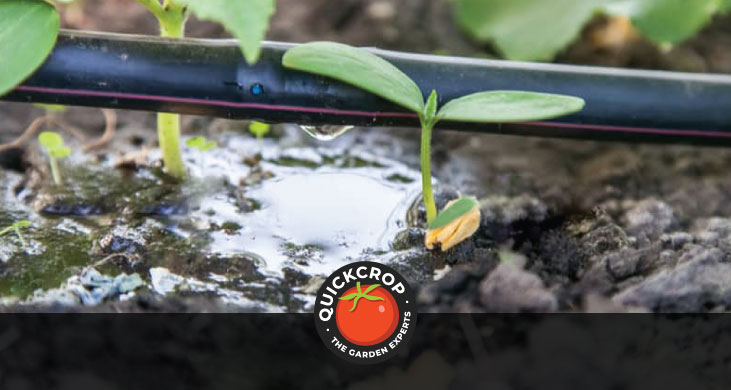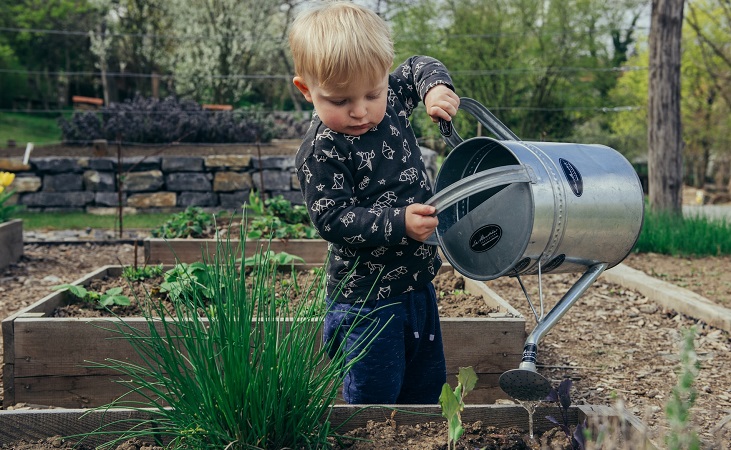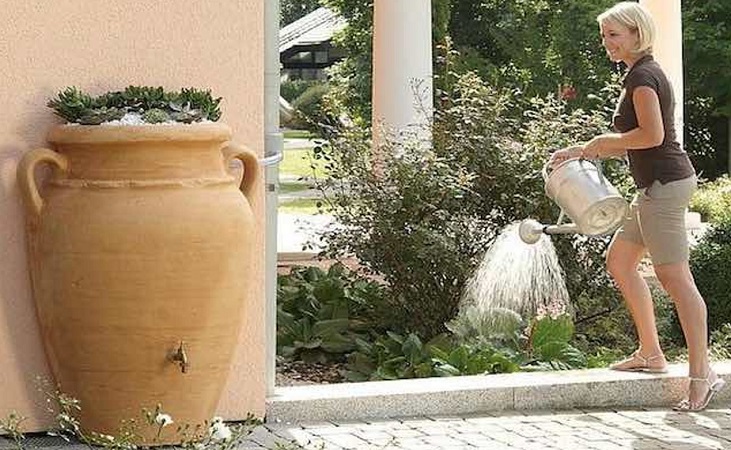Irrigation in the Vegetable Garden

Regular watering and sensible irrigation is essential to the development and healthy growth of any plant. Water is drawn from the root of the plant and transported through its capillary system, transferring valuable nutrients collected from the soil. Eventually it's released through the plant foliage by evaporation and transpiration. This water needs to be replaced in order to sustain steady growth. The moisture content of the soil or compost must be maintained for this to happen, taking into account losses due to surface run-off, drainage and evaporation.
Of course, excessive water consumption is something we want to avoid if we care about the environment and sustainable gardening. We should always look to use water in the most efficient way that we can. The good news is that you are more likely to harm or kill your plants by over rather than under watering, so your vegetable garden may not need as much attention as you think.

One example I regularly see is the unfortunate windowsill basil plant being killed with kindness, as every second person who comes to the sink decides to give it a drink. It's better to let the plant wilt in between watering, as basil comes from a warm climate originally and prefers to be kept a little on the dry side.
Methods of Garden Irrigation
A wide range of systems and equipment are available for watering the vegetable garden, from rainwater harvesting to sprinklers and dripper hoses.
- Hoses, Connectors and Nozzles Hoses are vital in transporting water around the garden, from water butts and taps to beds and greenhouses. It is possible to build a complete irrigation network using sections of hose and incorporating timers, manifolds, drippers and soakers.
- Sprays and Sprinklers Lawns and larger beds can be watered by installing sprayers connected through a network of tubing. Spray systems deliver a fine mist whereas sprinklers cover a wider area, with larger droplets which are less prone to evaporation.
- Timer Systems Mechanical or electrical timers can be used to control watering in a vegetable bed. This is ideal for periods when you are away from the garden, but most systems will not take into account ambient temperature and changeable weather conditions.
- Soaker Hoses Polytunnels will require constant watering to maintain the correct environment for vegetable cultivation. Soaker hoses laid upon the surface of the soil and covered with shallow mulch can provide a steady, regulated water flow, compensating for temperature fluctuations. They are made from a continuous porous material and provide a constant delivery, best used in conjunction with a timer or manual intervention to prevent overwatering.
- Drippers Plastic tubing is buried into the soil with small emitters placed near the plant roots for direct, targeted watering. The water is efficiently used with this method, avoiding the risk of flooding and overwatering. The supply can be regulated to water the plants only when necessary. Like soaker hoses, the dripper systems prevent foliage becoming wet - which could lead to mildew and fungal problems.
- Wicking and Capillary Watering Using the natural phenomena of capillary action, wicking systems provide a self-watering supply. Capillary matting allows water to be drawn from a tray as and when the plant requires, avoiding problems with overwatering and water deprivation. Individual wicks can be linked to a hose supply to service each plant’s specific demands. This system works well with container gardens, and with some adaptation it can be incorporated into larger beds.
- Watering Can This time honoured method provides the opportunity to engage with your garden at first hand and take advantage of the therapeutic benefits of pottering about. Hand watering is still the best method for feeding and for targeting individual plants that need special attention.
View Our Galvanised Watering Can with Copper Trim 9l
A note on Rainwater Harvesting
Clearly there is no point in paying for water when it falls from the sky for free! Harvesting the rain water from your roof via a water butt system is a very worthwhile investment, particularly if you have a polytunnel or greenhouse. You'd be surprised at just how much water you can collect from the average roof. There are many different types of butts and containers you can purchase, from the decorative to the purely functional.

View Our Water Butts & Tanks Range
Rainwater is very beneficial for plants due to its slightly acidic pH and higher oxygen levels. Collecting and storing it can also take some pressure off drainage systems and stave off flooding. If you are using water from a water butt, try to use it often to prevent water sitting for long periods and becoming stagnant - this can lead to the spread of fungal diseases.
A Guide to Watering Your Vegetable Garden

Watering young vegetable seedlings
Water is essential for the first phase of seed germination, as moisture penetrates the seed coat and causes the endosperm to swell. The swelling endosperm splits and growth begins. If the seed compost mix is too wet and compacted, drainage will be poor and the seeds will be deprived of oxygen. When this happens they will most likely fail to germinate, and rot.
Your initial watering after sowing should be quite heavy. It can be done in two or three stages, leaving about 30 minutes in between. These intervals allow the moisture to soak the compost and wet the shell of your newly sown seeds. The pots or trays can then be left alone for a few days until they dry out again before subsequent watering. It is also a good idea to leave your compost in the bag until ready for sowing: otherwise it can dry out too much and become difficult to wet properly.

If you are growing vegetable seedlings undercover (in a polytunnel or greenhouse), only water seedlings when they really need it. Doing so early in the day will prevent the leaves from being wet for long periods, which can bring on fungal diseases or sun scorch. Always check moisture levels with your finger. The top layer of compost may feel dry but there is still plenty of moisture underneath. I like to encourage seedlings to work for their reward as, just like us, it makes them stronger. A slightly under watered plant will develop a deeper root system if it’s made to search for water; while a pampered plant's roots will be shallow and less able to withstand drought.
Sometimes there is no getting away from a little green moss growing on the surface of the compost in your seed or plug trays. Too much is a sign of overwatering and cold wet compost, but don’t worry. It can usually be scraped off trays to let air down to the roots, saving your valuable seedlings. Some gardeners water from the base of the seed tray to avoid this, but I find less frequent watering with a lance or fine spray is easier to manage. A useful tip during cold weather is to store water in your greenhouse in barrels, tanks or watering cans to bring the temperature of the greenhouse up a little. You will often see dunking tanks in old glasshouses built for this purpose.

Watering in greenhouse and polytunnels
In smallish polytunnels or glasshouses, a watering can is usually sufficient. I quite like the slow pace as it gives me time to contemplate and check for upcoming jobs. Slow hand watering is also a good discipline as it forces me to look at the individual needs of each plant rather than evenly spraying a large area with a hose.
In a larger tunnel, sunken tubes or pipes close to plants will speed up watering and get moisture deep down into the root area, well away from the surface. Watering with capillary or soaker pipes is more efficient, as less water is lost through evaporation. It's also desirable in a tunnel as it waters the soil rather than the foliage of plants, which helps stave off fungal diseases.
View Our Drip Irrigation Systems

There is no need to water a polytunnel every day: you are better off deep watering once or twice a week by leaving your irrigation on for up to 6 hours, or giving a very heavy watering with a hose. Clearly you will need to tailor this depending on outside temperatures but less frequent, deep watering makes sense because it saves you time and -as with seedlings - makes the plants develop their root systems. I find my tomatoes and basil grow faster if left a little on the dry side. No plant likes to be left in cold wet soil or compost, but this is especially true for warm climate crops like tomatoes, peppers or cucumbers. I sometimes let my basil wilt between watering, which seems to help keep the plants vigorous and healthy.
I am often asked how my tomatoes taste so sweet, and my response is always this: less watering as they are maturing. Sometimes I won’t water for up to two weeks. A miserly watering regime lowers moisture content and increases sugar concentration. It also has the advantage of preventing splitting fruit, which is common late in the season.
Related Article: Sowing & Growing Tomatoes
Mulches are especially useful in tunnels as they reduce evaporation from the soil. Using well rotted compost, straw or even cardboard will dramatically reduce your watering bill.

In the greenhouse, a spray watering lance is handy for plants that are spread out towards the back of shelving and staging. You will need to keep on top of irrigation in the summer. Exactly how much you water will depend on individual plants, but during warmer spells it may be necessary to irrigate twice a day. Aim to water first thing in the morning as opposed to doing so in the midday heat: in hot conditions, water can evaporate before the plants have a chance to absorb it. Compost should be moist but not saturated.
The greenhouse is a favourable environment for seed propagation and young seedlings. Self-watering capillary mats can be placed under seedling trays to ensure a steady water supply. All it requires is that you set up a tray or guttering pipe just under the mat, keep it filled with water and allow the wicking action to do the rest.
View Our Bottle Top Waterer 4 Pack

Planting out seedlings
When planting out seedling plants it is far more beneficial to water seedlings the day before planting out, rather than after you have put them in the ground. The seedling plug should be very moist for the plant to survive until it gets roots down into garden soil. There is no point planting dry plugs and then trying to water them in, as the compost won’t get properly saturated.
Once a seedling gets established it's best left alone - unless you have a long drought lasting more than 2 weeks and are forced to water outdoor crops. Keep an eye on the weather forecast: there's no point wasting valuable time and water irrigating the garden when it's likely to rain the next day.

Outdoor watering
Generally speaking, the needs of outdoor plants will be dictated by the weather, with water availability being affected by wind, rain and temperature.
I very, very seldom water fruit and vegetables outdoors. Once they have germinated safely or have been planted out they are best left alone. The same applies to maturing vegetables as seedlings: treat ‘em mean! Letting vegetables work harder for moisture encourages them to send roots deeper and deeper into soil, resulting in a much stronger plant.
Also remember: once you start watering you must keep it up. As you are making your plants more dependent on you by spoiling them (I understand this is also the case with children!), your vegetables will have puny little roots in the top layers of soil which can’t support the plant in dry conditions. If you do need to water in an exceptionally dry year, practice infrequent heavy and deep watering for the same reason.

When to Water Your Vegetable Garden
The answer to this question is generally dependent on weather, soil condition and plant demand. Regular inspections of your garden will give you a better idea of when and how to water. Poke a finger into the bed and if it comes out wet your soil is moist enough. Another way of checking is to dig into the soil with a trowel. If the soil is still dry two inches below the surface, it's in need of watering.
For more precise and definitive info, you can use a moisture meter (some of these double as pH meters). Plants that are wilting or showing signs of heat stress will need your immediate attention. You should always adjust your timers or watering regime to provide a regular, steady water supply, while taking into consideration the prevalent conditions.

Vegetable Garden Watering Tips
- When watering the vegetable garden during warmer spells of weather, it's best to do so early in the morning. In higher midday temperatures the water can evaporate before the plant roots get a chance to fully absorb it. It also gives the leaves time to dry thoroughly - damp leaves can sometimes cause issues with mildew or plant disease.
- Another factor to take into account is your soil type. Sandy, fast-draining soils will need more frequent irrigation than clay or loamy soils; while clay soils tend to hold on to water and result in more runoff. Loamy soils are probably the best kind to work with when irrigating, hitting just the right balance between water retention and good drainage.
- When watering, always concentrate on the root of the plant: this is where absorption and nutrient uptake happens. Excess water on the plant foliage is unnecessary and will promote disease.
- Good mulch is crucial in retaining moisture, preventing evaporation and deterring wasteful water runoff. As a bonus, the mulch will eventually break down and improve the soil structure and health as it does so. Examples of good mulches are well-rotted garden manure, homemade compost and grass clippings. Always prevent the soil surface from drying out and developing a crust, which will affect absorption.
- Celery, celeriac, leeks, squash and parsnips need ample amounts of water. Some garden soils (very sandy) are just not suitable for such crops. Most herbs, however, enjoy slightly dryish conditions, so sandy soils are ideal. Plan your garden around your soil to avoid over using resources.
- As a general rule (depending on your soil type): the less drainage, the higher the drills, ridges, or raised beds you need to make. If you grow on drier soils, use low beds to gather moisture (as I did while growing in very sandy soil on the Aran Islands). Sandy soils dry out quicker and are more likely to need watering in a prolonged period of dry weather. Clay or loamy soils hold their moisture for longer.
- Never water the leaves of courgettes: the number one cause of powdery mildew is dry roots and wet leaves.
- An even supply of water gives the best crops. This is especially so with root vegetables, where a check in growth caused by drought can cause them to become woody. A period of drought followed by heavy rainfall will quickly swell vegetables like carrots or tomatoes, causing them to split. Lack of moisture in celery makes it stringy and bitter, while dry lettuce can also be bitter and is likely to run to seed.
- Be aware that overwatering can cause problems with your plants. It affects their ability to process oxygen and carbon dioxide, and can cause root damage and fungal growth. Excess water also encourages slug and snail activity. Overwatering in February or March brings with it cold wet roots and diseases like damping off. These can be the end of tender young seedlings before they have even got going.




